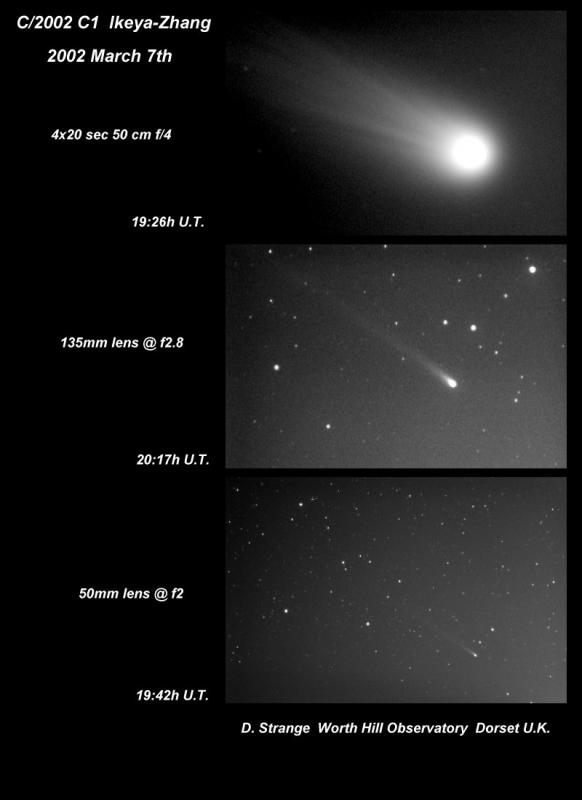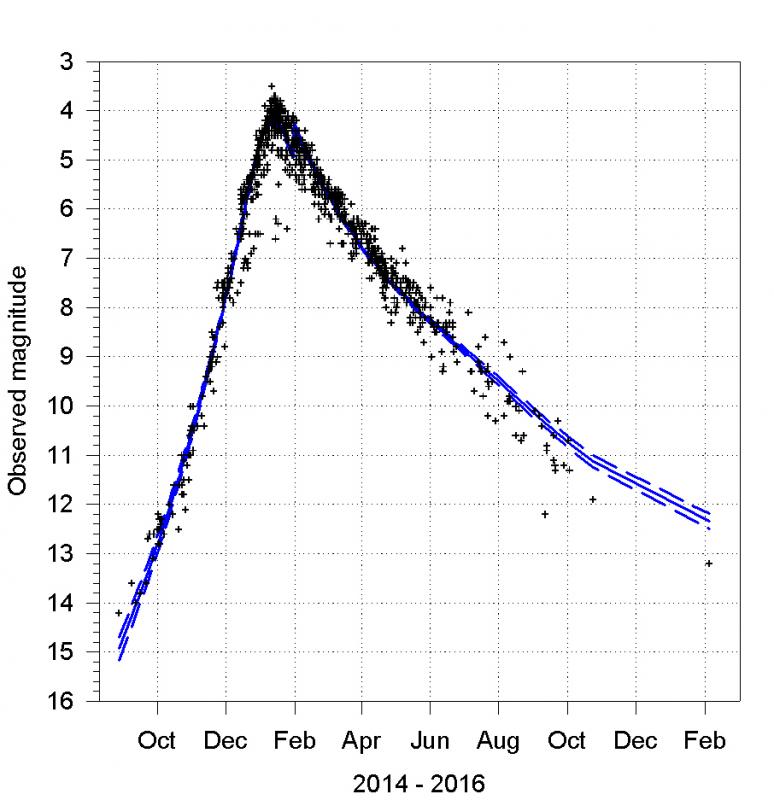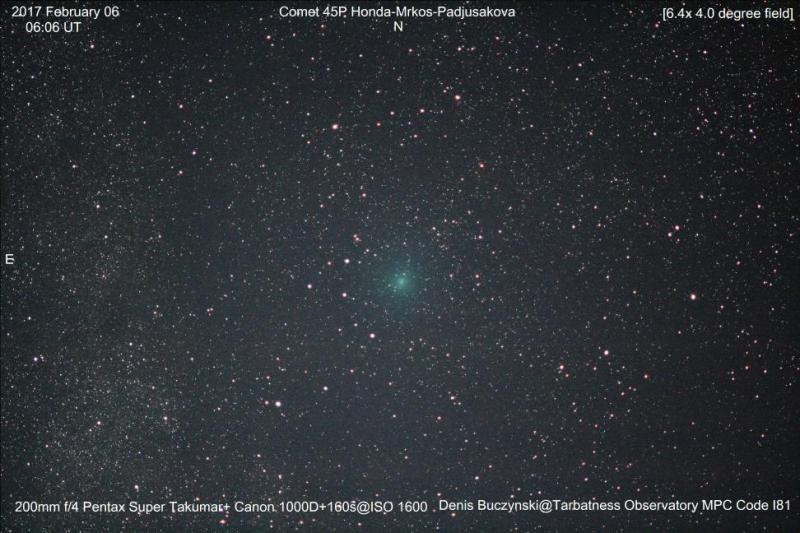2018 June 16
The visual observation of comets
Electronic imaging is now the mainstream of amateur observing however visual observations are still valuable and with practice are easy to carry out. There are usually several comets visible in simple equipment every year and observing them is a rewarding pastime. This description of techniques for the visual observation of comets is updated from an article published in the Journal in 2004.
Preamble

There are however some areas where the visual observer is more productive, does a better job, or provides continuity with the past. Variable star observation is one such area, where a visual observer can produce far more, though not necessarily as accurate, observations. For many variable stars the precise magnitude is not so important, but what is important is the general shape and amplitude of the light curve and a visual observer can easily provide this.
With comets there is a need for both electronic and visual observations (Figure 1) in order to provide continuity with historic observations. Periodic comets in particular evolve from apparition to apparition, and so to link them comparable observations are required. Nick James has developed a technique to reduce electronic observations to their visual equivalent, but this does need comparison with visual observations to ensure consistency.
The perception that visual observation is a thing of the past is apparent in the decreasing number of visual observations that are coming in, particularly from UK observers. In part this may be due to increasing light pollution, and it will certainly make a big difference to your observations if you can get to a dark sky site, however observation is still possible from a suburban back-garden and I have made observations of many comets from my home in central Cambridge.
Whilst a good site is one key aspect for visual observation, another is to match the equipment to the comet. As an example take comet 2P/Encke, which was very diffuse. I made an observation of the comet with the 0.3-m Northumberland refractor at the Cambridge University Observatory, estimating it at magnitude 12.4. The following morning I saw a report on the Internet saying that it was visible in binoculars. This seemed a bit unlikely given my observation, however the Cambridge site does suffer from light pollution, so the next evening I drove out to a dark sky site and was astounded to see the comet in 20×80 binoculars at an estimated magnitude of 9.9.
Features of a comet
The majority of comets show a diffuse coma, some arc minutes in diameter, with perhaps a nearly stellar nuclear condensation. This is not the true solid nucleus as seen from spacecraft, as this is far too small to be seen from any earth-based telescope.
The comet may show a tail, either composed of dust that is reflecting sunlight, or of ionised gas that is fluorescing in its own right. This tail normally, but not always, points away from the Sun. Under high power observers may see features such as jets or hoods in the inner coma, particularly if it is a bright comet relatively close to the Sun.
Visual observation is always subjective to a greater or lesser extent, because it is a synthesis of how the brain interprets what the eye sees. Everyone’s eyes see differently, indeed no two eyes are the same. Their spectral sensitivity may be different and the optical defects of each eye will also be different, with some more defective than others. Once the image has formed on the retina it has to be interpreted and this will depend on our background and preconceptions. Despite all these handicaps, visual observers still produce the goods and make valuable observations.
There are many reasons for making an observation. For amateur observers, personal satisfaction plays a large part and so an observation need not satisfy any scientific goal. It can be simply to tick on object off on a list, or the satisfaction gained in making an artistic drawing.
Amateur observers can however make significant contributions to science and the visual observation of comets is no exception. Visual magnitude estimates go towards making up a light curve, which allows the determination of the absolute magnitude of a comet. This gives a measure of the size of the nucleus and professional astronomers then draw up a statistical picture of the size distribution. This can tell us much about the evolutionary history of comets.
With periodic comets that have been observed over many returns it is possible to investigate if the absolute magnitude is changing with time and it is therefore essential to use consistent methods over a long period of time. Whilst electronic observation might give a precise magnitude, there are many problems in the reduction of electronic images. For example when visual observers were reporting 2P/Encke as being easily visible in binoculars, some reports on the Internet gave magnitudes fainter than 13.
The Comet Section
The Comet Section was formed in 1891, the year after the BAA was founded. Since 1945, 990 observers have contributed some 101,000 visual observations of 1200 comets, including returns of 80 periodic comets . Sadly the raw records prior to 1945 were lost during the Second World War, though there are some reports and analyses in the Journal. There are a number of Section publications, including Journal papers covering past comets, predictions on comets for the coming year, an observing guide, a Section newsletter and frequently updated web pages.
The first Director of the Section was W F Denning, who discovered five comets. The third Director, Dr A C D Crommelin, didn’t discover a comet, but did compute the true orbit of what is now known as 27P/Crommelin. Jonathan Shanklin was the 12th Director and although no comets were named after him, he discovered seven SOHO comets.
Today visual discovery is unlikely, thanks to professional search programmes such as LINEAR (Lincoln Laboratory Near Earth Asteroid Research) and PanSTARRS (Panoramic Survey Telescope and Rapid Response System), however Southern Hemisphere observers still stand a chance and since 2007 Terry Lovejoy has discovered no less than six comets. There is also a chance of discovery in what might be termed the twilight zone, which is too close to the Sun for the surveys and too far from the Sun for the SOHO (Solar and Heliospheric Observatory) LASCO (Large Angle Spectroscopic Coronagraph) coronagraphs, although even this area is covered by its SWAN (Solar Wind Anisotropies) camera and some professional survey programmes.
Observing equipment
Observing comets is rarely a naked eye pastime, so some visual aid is desirable. Binoculars are a good starting point and I have over half a dozen pairs ranging through 10×25, 3×40, 7×50, 10×50, 20×80 and 25×100. Of these the most frequently used are the 20x80B as the higher magnification and light grasp are good in light polluted conditions as well as in dark sky conditions. Telescopically I mostly use the old long focus refractors of the University Observatory – the Northumberland 0.30-m f20 and the Thorrowgood 0.20-m f14. One important reason for continuing to use these telescopes is to provide continuity with the past, but to provide comparison I also use a 0.15-m f8 Newtonian, a 0.20-m LX200 and a 0.33-m f4.5 Dobsonian. The Dobsonian mounting is a great benefit when comets are overhead!
The location of the observing site is important and ideally there should be no light pollution, but these days this is rarely possible. It is however worth making the effort to get to the best site that is readily accessible, particularly if you have portable equipment. As a guide you should be able to see a 7th magnitude comet in 7×50 binoculars for a comet above 45° altitude.
You will also need some accessories such as an observing log book, a dim red torch and finder charts. Good preparation prior to observing is very important as you can waste a lot of time looking in the wrong place for a faint comet. GOTO telescopes are a big help as are digital setting circles, but very often the comet is not immediately visible and then detailed charts are essential. Even then it is still not always obvious which star is which and I often use the traditional method of star hopping so that I am certain of the field. Using a planetarium style programme such as Megastar or Guide I prepare a wide field finder chart showing the track of the comet with respect to stars down to around 9th magnitude. For fainter comets I then have a narrow field view showing stars down to around 14th magnitude. The Computing Section also produces interactive charts for current comets.
Simple observations
The first step in observing a comet is simply to find it and confirm that it is (or is not) visible. This by itself can be a useful observation as a large number of comets are known to outburst, and so may be much brighter than the ephemeris prediction would suggest. Alerting other observers to such an outburst can allow detailed scientific study of the processes taking place.
The next stage in observing is to try making a drawing. Drawings are a good way of training the eye to see more detail and also provide a lasting record of what you saw. They can also be true works of art and perhaps the first of these was the drawing of a comet (which might be Halley’s) by Giotto. Guidance on drawing techniques is given in many books on observing and the styles most commonly used in comet drawings are the ‘smudged finger’, white on black or isophote methods. Section 4.8 of the Comet Observing Guide has further details and observing forms while the tutorial by Stewart Moore on sketching Deep Sky objects may also be of benefit.
Detailed observations
Visual observers should concentrate on the visual magnitude of the comet, with some associated description of the coma. Tail observation is better left to electronic observation as this is best suited to measuring lengths, angles and features in the tail. One point to remember when measuring the position angle of the tail (or other features) is to do so with respect to the celestial co-ordinate system and not with respect to the terrestrial one.
The diameter of the coma can most easily be measured with respect to pairs of stars in the field. The separation of these can then be measured later using one of the many planetarium programmes on the market. Another important aspect of the coma is its degree of condensation. An uncondensed coma is virtually the same brightness from centre to edge and is rated 0, a well condensed comet might be DC5 and a comet approaching close to the Sun often assumes a nearly starlike appearance of DC9. Comets that undergo outbursts, such as 29P/Schwassmann-Wachmann, often change from nearly stellar to very diffuse in the space of a week or two. There are illustrations of the scale in the section observing guide.

With comet observing we don’t usually stick to a standard field, as the comet’s position changes throughout the apparition as does its elevation, though some observers use the North Polar Sequence. The widespread availability of the Tycho and APASS catalogues for comparison star magnitudes has improved the consistency of estimates across widely separated fields for most comets.
No observer is perfect and we all tend to make small random errors in our estimates, superimposed on a bias from the mean, which give a significant scatter in the light curve. When all observations are taken together the mean curve is usually very consistent and this allows a good measurement of the magnitude parameters (Figure 3).

———————————-
Jonathan Shanklin was Director of the Comet Section for 25 years and is now the visual observations co-ordinator. His first comet was the infamous comet Kohoutek in 1973 and this stimulated a long term interest in visual observations. Professionally he was a meteorologist with the British Antarctic Survey and discovered the Antarctic Ozone Hole. After retirement he was recalled to service to make his 20th visit to the Antarctic in 2017/18.
[The Comet Section would love to receive your comet observations (images, sketches or observing notes) and why not also upload them to your BAA Member Page; recent comet observations uploaded to the members pages can be found here.]
https://britastro.org/wp-content/uploads/2018/06/Figure-2_1.JPG
https://britastro.org/wp-content/uploads/2018/05/Figure-2_1.JPG
https://britastro.org/wp-content/uploads/2018/05/Teaser.JPG
https://britastro.org/wp-content/uploads/2021/07/Teaser.JPG
https://britastro.org/wp-content/uploads/2021/07/Teaser.JPG
https://britastro.org/wp-content/uploads/2018/05/Figure-2_1.JPG
https://britastro.org/wp-content/uploads/2018/05/Figure-2_1.JPG
https://britastro.org/wp-content/uploads/2018/05/Figure-2_1.JPG
https://britastro.org/wp-content/uploads/2018/05/Figure-2_1.JPG
https://britastro.org/wp-content/uploads/2021/11/Teaser.JPG
https://britastro.org/wp-content/uploads/2021/11/Teaser.JPG
https://britastro.org/wp-content/uploads/2021/11/Teaser.JPG
https://britastro.org/wp-content/uploads/2021/11/Teaser.JPG
https://britastro.org/wp-content/uploads/2018/05/Figure-2_1.JPG
https://britastro.org/wp-content/uploads/2018/05/Figure-2_1.JPG
https://britastro.org/wp-content/uploads/2022/01/Teaser.JPG
https://britastro.org/wp-content/uploads/2022/01/Teaser.JPG
https://britastro.org/wp-content/uploads/2022/01/Teaser.JPG
https://britastro.org/wp-content/uploads/2022/01/Teaser.JPG
https://britastro.org/wp-content/uploads/2022/01/Teaser.JPG
https://britastro.org/wp-content/uploads/2022/01/Teaser.JPG
https://britastro.org/wp-content/uploads/2022/01/Teaser.JPG
https://britastro.org/wp-content/uploads/2022/01/Teaser.JPG
https://britastro.org/wp-content/uploads/2022/01/Teaser.JPG
https://britastro.org/wp-content/uploads/2018/05/Figure-2_1.JPG
https://britastro.org/wp-content/uploads/2018/05/Figure-2_1.JPG
https://britastro.org/wp-content/uploads/2018/05/Figure-2_1.JPG
https://britastro.org/wp-content/uploads/2022/02/Teaser.JPG
https://britastro.org/wp-content/uploads/2022/02/Teaser.JPG
https://britastro.org/wp-content/uploads/2022/02/Teaser.JPG
https://britastro.org/wp-content/uploads/2022/02/Teaser.JPG
https://britastro.org/wp-content/uploads/2022/02/Teaser.JPG
https://britastro.org/wp-content/uploads/2022/02/Teaser.JPG
https://britastro.org/wp-content/uploads/2022/02/Teaser.JPG
https://britastro.org/wp-content/uploads/2022/02/Teaser.JPG
https://britastro.org/wp-content/uploads/2022/02/Teaser.JPG
https://britastro.org/wp-content/uploads/2022/02/Teaser.JPG
https://britastro.org/wp-content/uploads/2022/02/Teaser.JPG
https://britastro.org/wp-content/uploads/2022/02/Teaser.JPG
https://britastro.org/wp-content/uploads/2022/02/Teaser.JPG
https://britastro.org/wp-content/uploads/2022/02/Teaser.JPG
https://britastro.org/wp-content/uploads/2022/02/Teaser.JPG
https://britastro.org/wp-content/uploads/2022/02/Teaser.JPG
https://britastro.org/wp-content/uploads/2022/02/Teaser.JPG
https://britastro.org/wp-content/uploads/2022/02/Teaser.JPG
https://britastro.org/wp-content/uploads/2018/05/Figure-2_1.JPG
https://britastro.org/wp-content/uploads/2022/02/Teaser.JPG
https://britastro.org/wp-content/uploads/2022/02/Teaser.JPG
https://britastro.org/wp-content/uploads/2022/02/Teaser.JPG
https://britastro.org/wp-content/uploads/2022/02/Teaser.JPG
https://britastro.org/wp-content/uploads/2022/02/Teaser.JPG
https://britastro.org/wp-content/uploads/2022/02/Teaser.JPG
https://britastro.org/wp-content/uploads/2022/02/Teaser.JPG
https://britastro.org/wp-content/uploads/2022/02/Teaser.JPG
https://britastro.org/wp-content/uploads/2022/02/Teaser.JPG
https://britastro.org/wp-content/uploads/2022/02/Teaser.JPG
https://britastro.org/wp-content/uploads/2022/02/Teaser.JPG
https://britastro.org/wp-content/uploads/2022/02/Teaser.JPG
https://britastro.org/wp-content/uploads/2022/02/Teaser.JPG
https://britastro.org/wp-content/uploads/2022/02/Teaser.JPG
https://britastro.org/wp-content/uploads/2022/02/Teaser.JPG
https://britastro.org/wp-content/uploads/2022/02/Teaser.JPG
https://britastro.org/wp-content/uploads/2022/02/Teaser.JPG
https://britastro.org/wp-content/uploads/2022/02/Teaser.JPG
https://britastro.org/wp-content/uploads/2022/02/Teaser.JPG
https://britastro.org/wp-content/uploads/2022/02/Teaser.JPG
https://britastro.org/wp-content/uploads/2022/02/Teaser.JPG
https://britastro.org/wp-content/uploads/2022/02/Teaser.JPG
https://britastro.org/wp-content/uploads/2022/02/Teaser.JPG
https://britastro.org/wp-content/uploads/2022/02/Teaser.JPG
https://britastro.org/wp-content/uploads/2022/02/Teaser.JPG
https://britastro.org/wp-content/uploads/2022/02/Teaser.JPG
https://britastro.org/wp-content/uploads/2022/02/Teaser.JPG
https://britastro.org/wp-content/uploads/2022/02/Teaser.JPG
https://britastro.org/wp-content/uploads/2022/02/Teaser.JPG
https://britastro.org/wp-content/uploads/2022/02/Teaser.JPG
https://britastro.org/wp-content/uploads/2022/02/Teaser.JPG
https://britastro.org/wp-content/uploads/2022/02/Teaser.JPG
https://britastro.org/wp-content/uploads/2022/02/Teaser.JPG
https://britastro.org/wp-content/uploads/2022/02/Teaser.JPG
https://britastro.org/wp-content/uploads/2022/02/Teaser.JPG
https://britastro.org/wp-content/uploads/2022/02/Teaser.JPG
https://britastro.org/wp-content/uploads/2022/02/Teaser.JPG
https://britastro.org/wp-content/uploads/2022/02/Teaser.JPG
https://britastro.org/wp-content/uploads/2022/02/Teaser.JPG
https://britastro.org/wp-content/uploads/2022/02/Teaser.JPG
https://britastro.org/wp-content/uploads/2022/02/Teaser.JPG
https://britastro.org/wp-content/uploads/2022/02/Teaser.JPG
https://britastro.org/wp-content/uploads/2022/02/Teaser.JPG
https://britastro.org/wp-content/uploads/2022/02/Teaser.JPG
https://britastro.org/wp-content/uploads/2018/05/Figure-2_1.JPG
https://britastro.org/wp-content/uploads/2022/03/Teaser.JPG
https://britastro.org/wp-content/uploads/2022/03/Teaser.JPG
https://britastro.org/wp-content/uploads/2022/03/Teaser.JPG
https://britastro.org/wp-content/uploads/2022/03/Teaser.JPG
| The British Astronomical Association supports amateur astronomers around the UK and the rest of the world. Find out more about the BAA or join us. |
